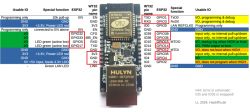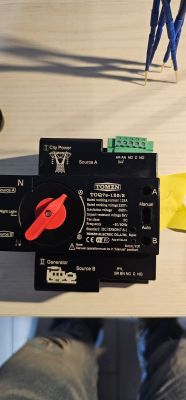Hello,
since I wanted to upgrade my classic RGB strips to RGBCC strips and the current controllers are running Tasmota, I looked for an RGBCCT controller at Tasmota and found this one: https://templates.blakadder.com/TY-6A-WiFi.html
Now it turned out that a BK7231T is installed there instead of an ESP. I then came across openbk on the Internet and am very excited that there is also a firmware similar to Tasmota for this!
So I have now flashed openbk on it, but am now faced with the problem that I can't get my new LED strip to work. I don't know the pinout, have tried various other RGBCCT device configurations and tried to copy the pin layout from Tasmota. However, I just can't get it to work by try and error. Others here in the forum seem to be able to find out the pinout directly, how can I find it out?
I got the controller from aliexpress:
https://de.aliexpress.com/item/725319185.html
Thanks in advance. Attached are a few pictures of the inner workings
![[BK7231T] Tuya RGBCCT LED Controller - not working, looking for pin assignment [BK7231T] Tuya RGBCCT LED Controller - not working, looking for pin assignment](https://obrazki.elektroda.pl/1835614600_1680021378_thumb.jpg)
![[BK7231T] Tuya RGBCCT LED Controller - not working, looking for pin assignment [BK7231T] Tuya RGBCCT LED Controller - not working, looking for pin assignment](https://obrazki.elektroda.pl/9721161600_1680021381_thumb.jpg)
since I wanted to upgrade my classic RGB strips to RGBCC strips and the current controllers are running Tasmota, I looked for an RGBCCT controller at Tasmota and found this one: https://templates.blakadder.com/TY-6A-WiFi.html
Now it turned out that a BK7231T is installed there instead of an ESP. I then came across openbk on the Internet and am very excited that there is also a firmware similar to Tasmota for this!
So I have now flashed openbk on it, but am now faced with the problem that I can't get my new LED strip to work. I don't know the pinout, have tried various other RGBCCT device configurations and tried to copy the pin layout from Tasmota. However, I just can't get it to work by try and error. Others here in the forum seem to be able to find out the pinout directly, how can I find it out?
I got the controller from aliexpress:
https://de.aliexpress.com/item/725319185.html
Thanks in advance. Attached are a few pictures of the inner workings
![[BK7231T] Tuya RGBCCT LED Controller - not working, looking for pin assignment [BK7231T] Tuya RGBCCT LED Controller - not working, looking for pin assignment](https://obrazki.elektroda.pl/1835614600_1680021378_thumb.jpg)
![[BK7231T] Tuya RGBCCT LED Controller - not working, looking for pin assignment [BK7231T] Tuya RGBCCT LED Controller - not working, looking for pin assignment](https://obrazki.elektroda.pl/9721161600_1680021381_thumb.jpg)






![[BK7231T] Tuya RGBCCT LED Controller - not working, looking for pin assignment [BK7231T] Tuya RGBCCT LED Controller - not working, looking for pin assignment](https://obrazki.elektroda.pl/8105621400_1680255432_thumb.jpg)
![[BK7231T] Tuya RGBCCT LED Controller - not working, looking for pin assignment [BK7231T] Tuya RGBCCT LED Controller - not working, looking for pin assignment](https://obrazki.elektroda.pl/6039513700_1680255452_thumb.jpg)